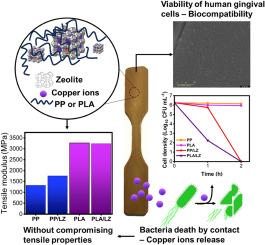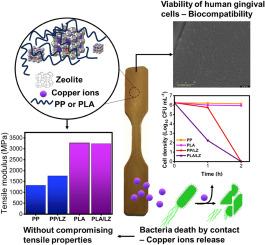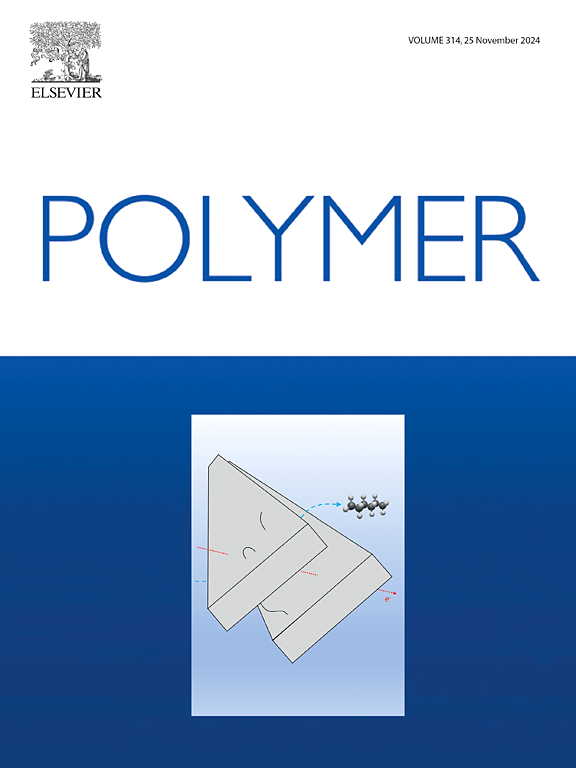Contact antibacterial and biocompatible polymeric, composite with copper zeolite filler and copper oxide, nanoparticles: A step towards new raw materials for the biomedical industry
IF 4.1
2区 化学
Q2 POLYMER SCIENCE
引用次数: 0
Abstract
This paper introduces a simple procedure for developing composite materials with antibacterial and biocompatible properties using polylactic acid (PLA) and polypropylene (PP). These composites incorporate three variants of zeolites in different percentages as filler agents: pure zeolite (PZ), copper ion-saturated zeolite (LZ), and copper-ion-saturated zeolite with copper oxide nanoparticles (LZ-nCu). The composites were prepared by the extrusion method and manufactured by injection molding. The impact of these zeolites on various material properties was evaluated, including morphology, thermal stability, mechanical properties, antibacterial capacity, biocompatibility, water absorption, and chemical resistance. The results demonstrated that (i) the incorporation of zeolite into the PP matrix improved thermal stability and increased the tensile modulus of the composites. For PLA-based composites, although there was a slight decrease in these values compared to pure PLA, they remained within acceptable ranges; (ii) zeolite LZ and LZnCu composites at 5 and 10 % by weight effectively inhibited the growth of Gram-positive and Gram-negative bacteria within a maximum of 2 h of contact; and (iii) composites containing 10 % by weight of PZ, LZ, or LZ-nCu showed reduced mechanical properties due to a tendency to form agglomerates. Additionally, LZ and LZ-nCu composites with the same percentage proved highly toxic to human gingival fibroblast cells (HGFs). PLA/LZ-nCu at 5 % and PP/LZ at 5 % composites exhibited antibacterial properties with bactericidal effects upon contact, high biocompatibility, and lower water absorption compared to the pure polymeric matrix. These results highlight the operational effectiveness of the procedure and suggest the potential of these composites in biomedical applications, such as in vitro dentistry, without contamination risks.


抗菌和生物相容性聚合物与沸石铜填料和氧化铜纳米颗粒的复合材料:迈向生物医学工业新原料的一步
本文介绍了一种利用聚乳酸(PLA)和聚丙烯(PP)开发具有抗菌和生物相容性复合材料的简单程序。这些复合材料采用了三种不同比例的沸石作为填充剂:纯沸石(PZ)、铜离子饱和沸石(LZ)和铜离子饱和沸石与氧化铜纳米颗粒(LZ-nCu)。复合材料采用挤压法制备,并通过注塑成型制造。评估了这些沸石对各种材料性能的影响,包括形态、热稳定性、机械性能、抗菌能力、生物相容性、吸水性和耐化学性。结果表明:(i) 在聚丙烯基体中加入沸石可提高复合材料的热稳定性并增加拉伸模量。对于聚乳酸基复合材料,虽然这些值与纯聚乳酸相比略有下降,但仍在可接受的范围内;(ii) 按重量计,沸石 LZ 和 LZnCu 复合材料的含量分别为 5%和 10%,可在最多 2 小时的接触时间内有效抑制革兰氏阳性和革兰氏阴性细菌的生长;(iii) 按重量计,复合材料中的 PZ、LZ 或 LZ-nCu 含量为 10%,由于容易形成团聚,因此机械性能有所降低。此外,相同比例的 LZ 和 LZ-nCu 复合材料对人类牙龈成纤维细胞(HGFs)有剧毒。与纯聚合物基质相比,聚乳酸/LZ-nCu(5%)和聚丙烯/LZ(5%)复合材料具有抗菌特性,接触后具有杀菌作用,生物相容性高,吸水性低。这些结果凸显了该程序的操作有效性,并表明这些复合材料在生物医学应用(如体外牙科)中具有潜力,且无污染风险。
本文章由计算机程序翻译,如有差异,请以英文原文为准。
求助全文
约1分钟内获得全文
求助全文
来源期刊

Polymer
化学-高分子科学
CiteScore
7.90
自引率
8.70%
发文量
959
审稿时长
32 days
期刊介绍:
Polymer is an interdisciplinary journal dedicated to publishing innovative and significant advances in Polymer Physics, Chemistry and Technology. We welcome submissions on polymer hybrids, nanocomposites, characterisation and self-assembly. Polymer also publishes work on the technological application of polymers in energy and optoelectronics.
The main scope is covered but not limited to the following core areas:
Polymer Materials
Nanocomposites and hybrid nanomaterials
Polymer blends, films, fibres, networks and porous materials
Physical Characterization
Characterisation, modelling and simulation* of molecular and materials properties in bulk, solution, and thin films
Polymer Engineering
Advanced multiscale processing methods
Polymer Synthesis, Modification and Self-assembly
Including designer polymer architectures, mechanisms and kinetics, and supramolecular polymerization
Technological Applications
Polymers for energy generation and storage
Polymer membranes for separation technology
Polymers for opto- and microelectronics.
 求助内容:
求助内容: 应助结果提醒方式:
应助结果提醒方式:


